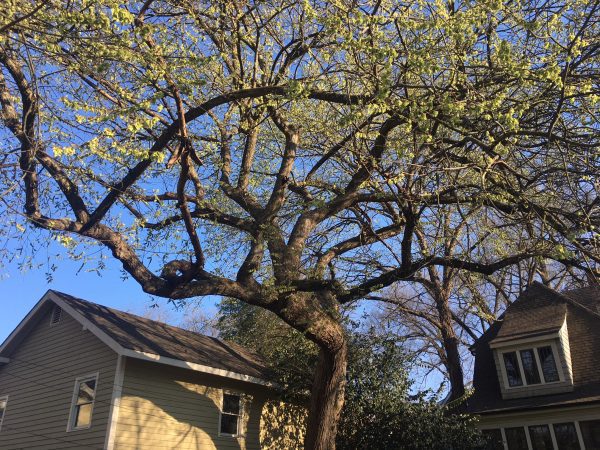A compromise between town and country

I was a preschooler with a bad case of eczema. My pediatrician sent us to an allergist in downtown Greensboro with an office on Elm Street. Growing up in the Uwharries, I’d never laid my country eyes on anything so grand — block after block of offices and shops towering over the sidewalks. (Including the historic Grissom building erected by an ill-fated relation, but that’s another story.)
Many cities named prominent streets for the graceful American elm (Ulmus americana). When Charles Darwin visited New Haven, Connecticut, it was already known as the City of Elms. According to Thomas Campanella, author of Republic of Shade: New England and the American Elm, Darwin wrote that the trees “bring about a kind of compromise between town and country, as if each had met the other halfway and shaken hands upon it.” A lifelong resident of Greensboro told me he’d heard their Elm Street had once been lined with the trees, but he didn’t remember them either.
Grown in the open, the trunk of an American elm tends to fork near the ground, giving the limbs plenty of latitude to create an arching canopy. They’re used to stunning effect in the alee along the Mall in New York’s Central Park. The canopy forms a cathedral of refined contortions. The Central Park Conservancy notes that it’s “one of the largest and last remaining stands of American elms in North America.”
In the 20th century, many elms fell victim to Dutch elm disease. Even though it began to impact the U.S. in 1930, the disease didn’t hit North Carolina until 1962. Ironically enough, it was first detected in Greensboro. The pathogen, spread by native and non-native beetles, could easily jump from tree to tree when they were planted cheek by jowl along a city street. (Monocultures are always vulnerable. Just ask a landowner whose loblolly plantation has been decimated by the Southern pine beetle.) Unlike the chestnut, which was virtually wiped from Eastern forests by blight, many elms survived, especially in the South where they were used less often as street trees.
My neighborhood in Charlotte still has a few remarkable specimens. One dwarfs a small brick home. The canopy spans roughly 100 feet, sprawling across three properties. It appears to be in decline, but it has apparently spawned replacements nearby. In another yard, a smaller tree has the typical forked trunk and twisting limbs, the form no doubt enhanced by its placement near an adjacent garage. Its struggle for space and light transcends awkwardness and achieves an arboreal elegance.
The American elm has other winning attributes, especially in March when its fruits are on display. Technically known as samaras, the fruits are papery and flat, encasing a single seed. They’re round – a little larger than the circumference of a pencil – with ciliate margins and a sharp notch at the bottom. They hang in chartreuse clusters, the perfect complement to a Carolina blue sky.
The slippery elm (Ulmus rubra) has similar coarsely-toothed leaves and can occur in the same habitats, but its fruits have a smooth margin. See examples at http://www.carolinanature.com/trees/ulal.html. This tree’s name might be familiar for other reasons. The mucilaginous inner bark can be used as an herbal remedy for sore throats, coughs and gastrointestinal issues. A paste can be applied topically for burns and inflammatory skin disorders. Another irony here – my trip to the allergist on Elm Street might have been avoided by turning to an option readily available in the Uwharries.
Both species are fairly common in the Piedmont, but in the Uwharries, the winged elm (Ulmus alata) seems most plentiful. It can often be identified by the corky ridges on some of the branches. I initially missed this feature when I became captivated by a specimen in my local park. The samaras first caught my eye. In certain conditions, the canopy resembles a piece of antique lace. Upon closer inspection, the fruits are smaller and elongated and have a rusty tinge. In addition, their margins bristle with tiny white hairs.
While it’s always a treat to see these trees in any setting, nothing compares with walking along the east bank of the Uwharrie River on a late afternoon in March. The winged elms’ fuzzy fruits backlit by the sun – the forest dappled with translucence and sparkle – seem to embody the life force about to burst forth with the onset of spring.